Time:2025-07-15
The Critical Role of High-Brightness Neon in Nocturnal Retail
In urban landscapes where nightlife thrives and foot traffic peaks after sunset, high-brightness neon shop signs have emerged as indispensable tools for businesses seeking to dominate night-time visibility. These specialized signs transcend traditional illumination, combining the iconic allure of neon with advanced brightness optimization technologies to cut through darkness, fog, and ambient city light. From 24/7 convenience stores to vibrant nightlife venues, high-brightness neon signs act as beacons, guiding customers and reinforcing brand identity when visibility matters most. This article explores the technical innovations, design principles, and strategic applications of these signs, offering a comprehensive guide for retailers, designers, and signage professionals aiming to master nocturnal brand exposure.
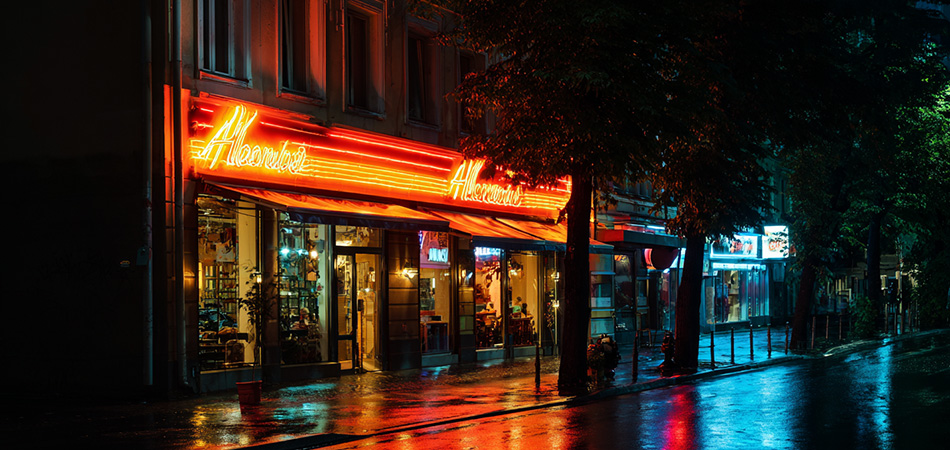
Technical Foundations: Engineering for Night-Time Dominance
The Science of High-Brightness Neon Illumination
LED Neon vs. Traditional Glass Neon for Night Use
LED Neon Flex: The Modern Powerhouse:
High-Intensity LEDs: Surface-mounted diodes engineered for maximum light output, emitting consistent brightness across the neon strip. Advanced packaging techniques, such as chip-on-board (COB) technology, concentrate light emission, reducing optical loss and enhancing clarity at long distances.
Low-Voltage Efficiency: Operates at 12V/24V DC, delivering up to 30% higher brightness than standard LED neon while maintaining energy efficiency, ideal for all-night operation without exorbitant electricity costs.
Glass Neon: The Classic with a Bright Twist:
Gas Mixture Optimization: Modern glass neon uses enhanced gas blends (e.g., krypton-neon mixtures) to boost luminosity, paired with thicker glass tubing to minimize light diffusion and improve color purity in low-light conditions.
Brightness Enhancement Technologies
Optical Lens Systems:
Micro-Prism Diffusers: Embedded within silicone/PVC casings, these lenses direct light outward, reducing glare and increasing perceived brightness by 20-30% compared to standard neon flex.
Reflective Backings: Aluminum or mirrored acrylic panels behind neon letters bounce stray light forward, creating a halo effect that enhances overall brightness without increasing energy consumption.
Dynamic Brightness Control:
Photocell Sensors: Auto-adjust brightness based on ambient light levels, ensuring signs are intensely visible at night while avoiding over-illumination during the day, a critical feature for compliance with light pollution regulations.
PWM (Pulse Width Modulation): Smoothly transitions between brightness levels, enabling "Night Mode" with 100% output and "Day Mode" with reduced intensity, managed via programmable controllers.
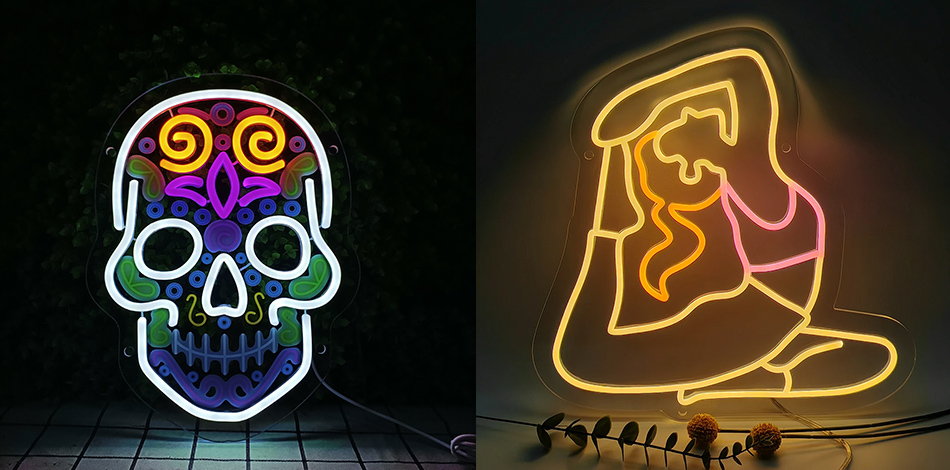
Design Principles for Nocturnal Visibility
Optical Design for Maximum Impact
Light Distribution Strategies:
Uniform Brightness Mapping: Using 3D modeling to ensure no hotspots or dim areas in large signs, with LED spacing optimized for the sign’s size (e.g., closer spacing for small letters, wider spacing for large-scale designs).
Edge-Lighting Techniques: For flat-back neon signs, edge-mounted LEDs channel light through acrylic panels, creating a seamless, high-brightness surface ideal for logos and symbols that need to stand out from dark backgrounds.
Viewing Distance Optimization:
Long-Range Legibility: Sans-serif fonts with bold strokes for signs visible from 50+ meters (e.g., highway-facing stores), while script fonts with enhanced outline lighting work for closer-range visibility (e.g., boutique storefronts).
Color Psychology for Night-Time Appeal
High-Contrast Color Palettes:
Warm vs. Cool Tones: Red and yellow neon dominate dark environments due to their high visibility, while blue and green work well in areas with competing warm light sources (e.g., streetlights).
Blackout Contrast: Pairing neon letters with matte black backings or storefront surfaces to create maximum color contrast, a technique proven to enhance legibility in low-light conditions.
Dynamic Color Sequencing:
Chasing Effects: Programmable color transitions (e.g., red → yellow → white) that draw the eye, ideal for entertainment venues or late-night eateries.
Pulsing Brightness: Short bursts of increased brightness (10-15% above baseline) at regular intervals, a subtle yet effective way to capture fleeting attention from passing traffic.
Structural Design for Light Efficiency
Material Selection for Minimal Light Loss:
Transparent Silicone Casings: High-clarity silicone with 95% light transmission, minimizing yellowing over time and ensuring colors remain vibrant after years of nighttime use.
Aluminum Heat Sinks: Integrated into sign frames to dissipate heat from high-intensity LEDs, preventing brightness degradation caused by overheating.
Aerodynamic Shapes:
Slim Profiles: Reduced thickness (10-15mm) for neon flex, allowing signs to be mounted closer to walls without shadowing, the ideal for narrow storefronts in urban alleyways.
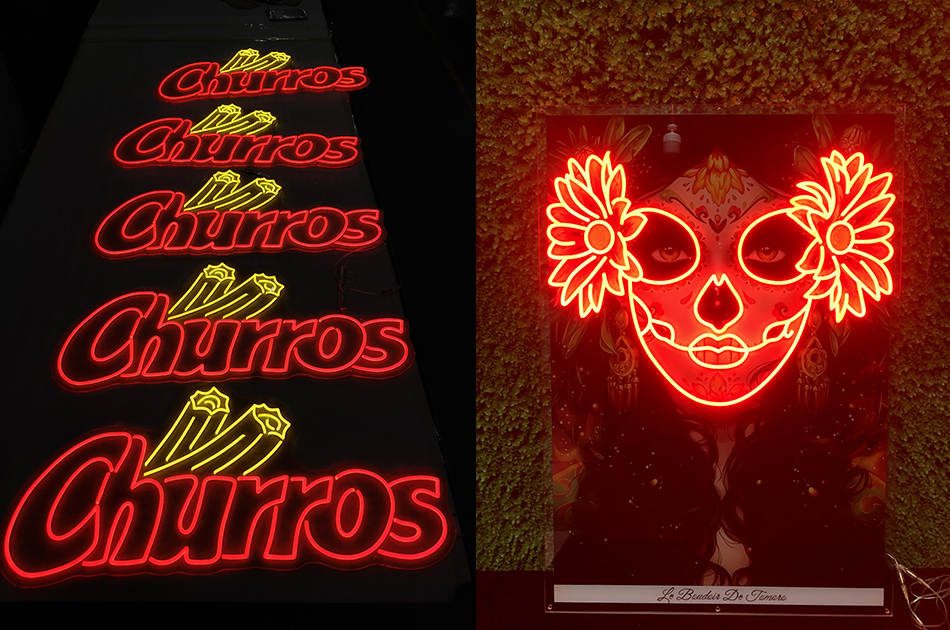
Strategic Applications in Night-Time Retail
24/7 Retail and Convenience Stores
Gas Stations and Pharmacies:
Highway Visibility: Oversized neon signs with bold numerals (e.g., "24") and brand logos, using red and white neon to stand out against pitch-black surroundings. Photocell sensors ensure full brightness all night, guiding tired drivers and late-night shoppers.
Emergency Access Markers: Subtle high-brightness neon arrows pointing to ATMs or emergency exits, using low-energy LEDs that remain visible without overwhelming the primary signage.
Convenience Stores in Urban Centers:
Multi-Layered Signage: Primary brand logos in super-bright blue neon, paired with scrolling text displays in yellow for promotions ("COFFEE NOW SERVED"), all synchronized to pulse gently to attract foot traffic from blocks away.
Nightlife and Entertainment Venues
Bars, Clubs, and Theaters:
Thematic Brightness Zones: Entrance signs using UV-reactive neon in vibrant purples and greens, complemented by high-brightness white neon for event schedules, creating a dynamic visual hierarchy that entices crowds from across the street.
Dance Floor Backdrops: Large-scale neon installations with adjustable brightness, dimming during performances to focus attention on stages, then intensifying during intermissions to maintain energy in the venue.
Late-Night Eateries:
Drive-Thru Signage: High-brightness neon menus with anti-glare coatings, ensuring visibility for drivers even in rainy or foggy conditions. Warm yellow neon for food imagery (e.g., burgers, coffee cups) triggers appetite appeal in low light.
Service-Based Businesses and Healthcare
24-Hour Clinics and Emergency Services:
Safety-Centric Design: Red cross symbols in ultra-bright neon, paired with "EMERGENCY" in white, using strobe effects during power outages to maintain visibility during blackouts.
Hospital Wayfinding: High-brightness neon arrows and room numbers in healthcare facilities, guiding visitors through dimly lit corridors with consistent, non-glare illumination.
Luxury and High-End Retail
Boutiques and Showrooms:
Elegant High-Brightness: Soft white neon for luxury brand logos, mounted on frosted acrylic backings to create a diffused glow that complements nighttime window displays without overpowering product visuals.
Seasonal Campaigns: Programmable neon borders that change brightness and color to highlight limited-edition collections, such as a slow fade from gold to red during holiday seasons.
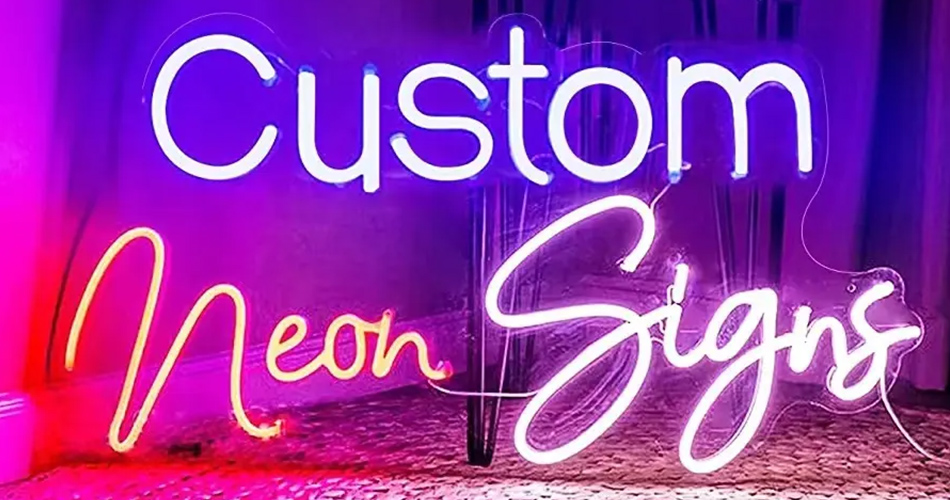
Installation and Maintenance for Sustained Brightness
Professional Installation: Optimizing Light Projection
Angle and Height Calibration:
Gaze-Level Placement: Mounting signs 3-4 meters above ground for maximum visibility from both pedestrians and drivers, with a 15-degree downward tilt to direct light toward viewing angles.
Anti-Glare Mounting: Using adjustable brackets to avoid light reflection off wet surfaces (e.g., rainy streets), a critical step for urban storefronts.
Power Stability:
Surge Protection: Installing voltage regulators to prevent brightness fluctuations caused by grid instability, essential for areas with inconsistent power supply.
Backup Power Systems: Uninterruptible power supplies (UPS) for critical signs, ensuring 30+ minutes of full brightness during outages, vital for emergency exits or 24/7 businesses.
Routine Maintenance: Preserving Nocturnal Impact
Monthly Cleaning:
Silicone/Glass Care: Gently wiping with microfiber cloths and isopropyl alcohol to remove dust and light pollution residue, avoiding abrasive materials that scratch diffusers.
Lens Inspection: Checking for water spots or bird droppings on optical lenses, which can reduce brightness by up to 15% if left uncleaned.
Quarterly System Checks:
LED Output Test: Using a lux meter to verify brightness levels, replacing any underperforming segments promptly to maintain uniformity.
Controller Calibration: Resetting photocell sensors to account for seasonal light changes (e.g., shorter nights in summer requiring later activation times).
Annual Component Service:
Heat Sink Cleaning: Removing dust from aluminum heat sinks to maintain optimal thermal performance, preventing LED degradation from overheating.
Seal Inspection: Replacing weathered gaskets in outdoor signs to prevent moisture ingress that could dim brightness over time.
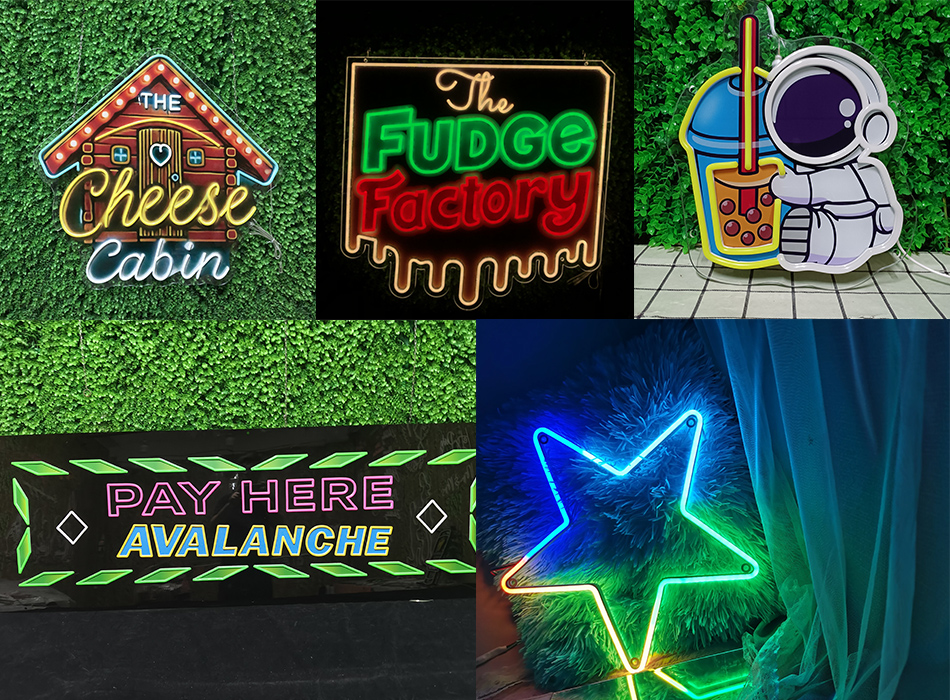
Key Considerations When Commissioning High-Brightness Signs
Brightness Certification and Compliance
Photometric Testing: Requesting luminance reports from suppliers, ensuring signs meet regional standards for night-time visibility (e.g., minimum 500 cd/m² for highway signs, 300 cd/m² for urban storefronts).
Light Pollution Compliance: Using diffusers and directional optics to avoid upward light spill, adhering to local ordinances (e.g., Dark Sky initiatives) that restrict excessive nighttime illumination.
Supplier Expertise and Technology
High-Brightness Specialization: Choosing manufacturers with in-house photometric labs, capable of customizing LED density and optics for specific visibility needs (e.g., fog-prone regions requiring extra brightness).
Color Consistency Guarantees: Ensuring suppliers use bin-matched LEDs to prevent color variance across the sign, a common issue in low-quality high-brightness installations.
Customization for Brand and Context
Dynamic Content Integration: Opting for signs with RGBW capabilities, allowing brands to switch between primary colors and high-brightness white for promotional events (e.g., "SALE" in flashing red neon).
Modular Design: Selecting signs with replaceable high-brightness modules, enabling easy upgrades to newer LED technology without full sign replacement.
Budget and Lifespan Planning
Cost-Benefit Analysis: While high-brightness signs cost 10-20% more than standard neon, factor in increased foot traffic and brand recall, with ROI often recouped within 12-18 months for high-traffic locations.
Lifespan Expectations: LED-based signs offer 50,000+ hours of high-brightness operation, with proper maintenance extending useful life to 7-10 years, far exceeding traditional neon’s 3-5 year lifespan under constant use.
Innovations in High-Brightness Neon Technology
Advanced Optical Innovations
Micro-LED Arrays: Emerging technology with 50% higher brightness in half the size, enabling ultra-compact high-brightness signs for intricate logo details.
Holographic Diffusers: Create the illusion of floating neon letters by dispersing light in multiple directions, enhancing visibility from acute angles (e.g., corner storefronts).
Smart Brightness Management
AI-Driven Adaptation: Machine learning algorithms that analyze real-time foot traffic data to adjust brightness levels, intensifying output during peak nightlife hours and dimming during lulls to conserve energy.
Voice-Activated Control: Integration with smart city systems, allowing municipal authorities to temporarily increase brightness during events or emergencies (e.g., guiding crowds during festivals).
Sustainable High-Brightness Solutions
Energy-Regenerative Systems: Harvesting heat from high-brightness LEDs to power auxiliary functions (e.g., security cameras), reducing overall energy consumption.
Solar-Enhanced Brightness: Hybrid systems combining solar panels with high-efficiency LEDs, ensuring sustained brightness even in remote locations without reliable grid power.
Overcoming Night-Time Visibility Challenges
Challenge 1: Glare from Wet Surfaces
Solution: Applying anti-reflective coatings to sign casings and using downward-angled mounts, reducing light reflection on rainy pavement that can obscure visibility.
Challenge 2: Color Fade in High-Intensity Use
Solution: Using UV-stabilized silicone and LED diodes with color retention warranties, paired with automatic brightness compensation as LEDs age, maintaining consistent visibility over time.
Challenge 3: Light Pollution Concerns
Solution: Incorporating shielded optics that direct light downward, combined with motion sensors that activate full brightness only when pedestrians are detected, balancing visibility and environmental responsibility.
Challenge 4: Competing Light Sources
Solution: Conducting light audits to identify dominant ambient light colors (e.g., sodium vapor streetlights) and selecting neon hues that contrast sharply (e.g., blue neon against orange streetlight glow).
Conclusion: Mastering the Night with High-Brightness Neon
High-brightness neon shop signs are more than just illumination; they are strategic tools for nocturnal brand dominance. By leveraging advanced optics, intelligent controls, and meticulous design, these signs transform darkness into an opportunity, guiding customers, enhancing safety, and elevating brand presence when most businesses fade into the night.
As urban nightlife continues to evolve, the demand for signs that balance brightness, efficiency, and aesthetic appeal will only grow. Retailers who invest in high-brightness neon gain a competitive edge, ensuring their storefronts remain visible, inviting, and unforgettable long after the sun sets. In the realm of night-time retail, where attention is fleeting and competition is fierce, these signs stand as beacons of excellence, proving that brilliance after dark is not just about light—it’s about strategic, innovative design that lights the way to success.